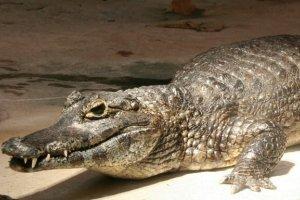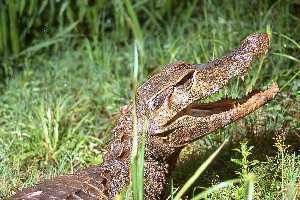Kingdom animalia
Phylum Chordata
Class reptile
Order crocodylia
Family Alligatoridae
The Order Crocodylia appeared on our planet at least 200 million years ago, harboring animals with great growth capacity. in the first years of life, stopping their development only when they reach sexual maturity, at approximately fifteen years of life. They are large and have a life expectancy of approximately fifty years. This order includes three families: the crocodiles (Crocodylidae), the gharials (Gavialidae) and the alligators, alligators and caimans (Alligatoridae). The latter have as differential features, the fact that their head and muzzle are shorter and wider, and the ability to not show their lower teeth when closing their mouths.
The Alligatoridae are divided into four genera, with a total of eight species.
ALLIGATOR GENRE:
Alligator (Alligator mississippiensis). Native to the United States. Conservation status: not at risk.

China Alligator (Alligator sinensis). Native to China. Conservation Status: Critically Endangered.

CAIMAN GENRE:
Alligator (caiman crocodilus). Native to Brazil, Colombia, Costa Rica, Ecuador, El Salvador, French Guiana, Guatemala, Guyana, Honduras, Mexico, Nicaragua, Panama, Peru, Suriname, Trinidad and Tobago and Venezuela; and introduced in Cuba, Puerto Rico and the United States. Conservation status: minimal risk.

Yellow-throated Alligator (caiman latirostris). Native to Argentina, Bolivia, Brazil, Paraguay and Uruguay. Conservation status: minimal risk.

Alligator-of-the-swamp (Caiman Yacare). Native to Argentina, Bolivia, Brazil and Paraguay. Conservation status: minimal risk.

MELANOSUCHUS GENRE:
Alligator-açu (Melanosuchus niger). Native to Bolivia, Brazil, Colombia, Ecuador, French Guiana, Guyana and Peru; and probably Venezuela. Conservation status: minimal risk.

PALEOSUCHUS GENRE:
Dwarf Alligator (Paleosuchus palpebrosus). Native to Bolivia, Brazil, Colombia, Ecuador, French Guiana, Guyana, Paraguay, Peru, Suriname and Venezuela. Conservation status: minimal risk.

Alligator Crown (Paleosuchus trigonatus). Native to Bolivia, Brazil, Colombia, Ecuador, French Guiana, Guyana, Peru, Suriname and Venezuela. Conservation status: minimal risk.

Curiosity:
The alligator-açu is considered the largest alligator in our country, with the capacity to reach five meters in length. It was heavily hunted in the 50s and 60s, seeking to use its leather to make luxury bags and shoes. This action was facilitated by the temperament of this animal, which is more peaceful compared to other species.
In addition to hunting, aiming at the hide and meat of these animals, another significant factor regarding the ability to compromise alligator populations is the pollution of water and its surroundings.
By Mariana Araguaia
Biologist, specialist in Environmental Education
Brazil School Team
Vertebrates -Animals -Brazil School

